Chemical Topping with Mepiquat Chloride at Flowering Does Not Compromise the Maturity or Yield of Cotton
Abstract
:1. Introduction
2. Materials and Methods
2.1. Location and Cultivar
2.2. Experimental Design and Field Management
2.3. Measurement
2.3.1. Boll Age
2.3.2. Plant Mapping
2.3.3. Boll Accumulation over Cohorts
2.3.4. Boll Opening Percentage (BOP) before Defoliation in September
2.3.5. Yield and Yield Components
2.4. Data Analysis
3. Results
3.1. Boll Age
3.2. Spatial Distribution of Bolls
3.3. Accumulated Fraction of Bolls by Bloom Cohort
3.4. Boll Opening Percentage at Defoliation
3.5. Yield and Yield Components
4. Discussion
4.1. Boll Distribution, Accumulation, and Maturity Varied Greatly with Environment and Management Practices
4.2. Chemical Topping Did Not Affect Cotton Maturity Compared with Manual Topping
4.3. Chemical Topping Did Not Alter Yield Unless under Drought Stress
5. Conclusions
Author Contributions
Funding
Data Availability Statement
Acknowledgments
Conflicts of Interest
References
- Norton, E.R.; Silvertooth, J.C.; Galadima, A. Residual soil nitrogen evaluations in irrigated soils of the desert southwest. In Proceedings of the Beltwide Cotton Conferences, New Orleans, Louisiana, 9–12 January 2007; Volume 2245, pp. 1–9. [Google Scholar]
- Hearn, A. OZCOT: A simulation model for cotton crop management. Agric. Syst. 1994, 44, 257–299. [Google Scholar] [CrossRef]
- Gwathmey, C.O.; Bange, M.P.; Brodrick, R. Cotton crop maturity: A compendium of measures and predictors. Field Crop. Res. 2016, 191, 41–53. [Google Scholar] [CrossRef]
- Chalise, D.P.; Snider, J.L.; Hand, L.C.; Roberts, P.; Vellidis, G.; Ermanis, A.; Collins, G.D.; Lacerda, L.N.; Cohen, Y.; Pokhrel, A.; et al. Cultivar, irrigation management, and mepiquat chloride strategy: Effects on cotton growth, maturity, yield, and fiber quality. Field Crop. Res. 2022, 286, 108633. [Google Scholar] [CrossRef]
- Liang, F.-B.; Yang, C.-X.; Sui, L.-L.; Xu, S.-Z.; Yao, H.-S.; Zhang, W.-F. Flumetralin and dimethyl piperidinium chloride alter light distribution in cotton canopies by optimizing the spatial configuration of leaves and bolls. J. Integr. Agric. 2020, 19, 1777–1788. [Google Scholar] [CrossRef]
- Rademacher, W. Plant Growth Regulators: Backgrounds and Uses in Plant Production. J. Plant Growth Regul. 2015, 34, 845–872. [Google Scholar] [CrossRef]
- Dong, H.; Li, W.; Li, Z.; Wei, T.; Zhang, D. Review on utilization of vegetative branches of cotton plants. Cotton Sci. 2003, 15, 313–317. [Google Scholar]
- Li, F.; Xi, W.; Wang, X.; Du, M.; Zhou, C.; Yin, X.; Xu, D.; Lu, H.; Tian, X.; Li, Z. Cotton chemical topping with mepiquat chloride application in the north of Yellow River valley of China. Sci. Agric. Sin. 2016, 49, 2497–2510. [Google Scholar]
- Zhao, Q.; Zhou, C.; Zhang, J.; Li, S.; Yun, Y.; Tian, X. Effect of chemical detopping on the canopy and yield of cotton (Gossypium hirsutum) in south Xinjiang. Cotton Sci. 2011, 23, 329–333. [Google Scholar]
- Liao, B.; Ren, X.; Du, M.; Eneji, A.E.; Tian, X.; Li, Z. Multiple applications of mepiquat chloride enhanced development of plant-wide fruits from square initiation to boll opening in cotton. Crop Sci. 2021, 61, 2733–2744. [Google Scholar] [CrossRef]
- He, Z.; Li, P.; Xi, H.; Li, Z.; Bai, L. The using and development of DPC chemical controlling technique in cotton culture. J. China Agric. Univ. 1991, 17, 58–63. [Google Scholar]
- Cook, D.R.; Kennedy, C.W. Early Flower Bud Loss and Mepiquat Chloride Effects on Cotton Yield Distribution. Crop Sci. 2000, 40, 1678–1684. [Google Scholar] [CrossRef]
- He, Z.; Min, X.; Li, P.; Xi, H. Study on effects of DPC on endogenous hormone levels and the development of cotton bolls. Acta Agron. Sin. 1990, 16, 252–258. [Google Scholar]
- Zhang, J.; Han, Y.; Li, Y.; Li, X.; Wang, G.; Wang, Z.; Du, W.; Feng, L. Inhibition of apical dominance affects boll spatial distribution, yield and fiber quality of field-grown cotton. Ind. Crop. Prod. 2021, 173, 114098. [Google Scholar] [CrossRef]
- Schaefer, C.; Nichols, B.; Collins, G.; Whitaker, J.; Bednarz, C.; Main, C.; Ritchie, G. Cotton Maturity Determination through Vertical Mapping. Crop Sci. 2016, 57, 62–70. [Google Scholar] [CrossRef]
- Gwathmey, C.O.; Clement, J.D. Alteration of cotton source–sink relations with plant population density and mepiquat chloride. Field Crop. Res. 2010, 116, 101–107. [Google Scholar] [CrossRef]
- Li, F.; Du, M.; Xu, D.; Chen, J.; Tian, X.; Li, Z. Effects of chemical topping with fortified mepiquat chloride on cotton growth, yield and maturity under different plant densities and nitrogen rates in the Yellow River valley region of China. J. China Agric. Univ. 2018, 23, 10–22. [Google Scholar]
- Dai, J.; Tian, L.; Zhang, Y.; Zhang, D.; Xu, S.; Cui, Z.; Li, Z.; Li, W.; Zhan, L.; Li, C.; et al. Plant topping effects on growth, yield, and earliness of field-grown cotton as mediated by plant density and ecological conditions. Field Crop. Res. 2022, 275, 108337. [Google Scholar] [CrossRef]
- Qi, H.-K.; DU, M.-W.; Meng, L.; Xie, L.-W.; Egrinya, E.A.; Xu, D.-Y.; Tian, X.-L.; Li, Z.-H. Cotton maturity and responses to harvest aids following chemical topping with mepiquat chloride during bloom period. J. Integr. Agric. 2022, 21, 2577–2587. [Google Scholar] [CrossRef]
- Reddy, A.R.; Reddy, K.R.; Hodges, H.F. Mepiquat chloride (PIX)-induced changes in photosynthesis and growth of cotton. Plant Growth Regul. 1996, 20, 179–183. [Google Scholar] [CrossRef]
- Stewart, S.D.; Sterling, W.L. Dynamics and Impact of Cotton Fruit Abscission and Survival. Environ. Èntomol. 1988, 4, 629–635. [Google Scholar] [CrossRef]
- Bednarz, C.W.; Bridges, D.C.; Brown, S.M. Analysis of Cotton Yield Stability Across Population Densities. Agron. J. 2000, 92, 128–135. [Google Scholar] [CrossRef]
- Kerby, T.A.; Buxton, D.R. Competition Between Adjacent Fruiting Forms in Cotton. Agron. J. 1981, 73, 867–871. [Google Scholar] [CrossRef]
- Bednarz, C.W.; Shurley, W.D.; Anthony, W.S.; Nichols, R.L. Yield, Quality, and Profitability of Cotton Produced at Varying Plant Densities. Agron. J. 2005, 97, 235–240. [Google Scholar] [CrossRef]
- Qi, H.; Wang, S.; Xu, D.; Lu, Z.; Zhao, W.; Hao, Y.; Zhang, X.; Li, W.; Han, H.; Wang, J.; et al. Cotton chemical topping by applying DPC in different cotton-growing regions. Cotton Sci. 2020, 32, 425–437. [Google Scholar]
- Mao, L.; Zhang, L.; Zhao, X.; Liu, S.; van der Werf, W.; Zhang, S.; Spiertz, H.; Li, Z. Crop growth, light utilization and yield of relay intercropped cotton as affected by plant density and a plant growth regulator. Field Crop. Res. 2014, 155, 67–76. [Google Scholar] [CrossRef]
- He, Z.; Xi, H.; Yang, B.; Li, P.; Han, B. The key to get good yield of cotton by inducing the response to DPC towards a planned direction and in planned strength. J. China Agric. Univ. 1984, 10, 19–28. [Google Scholar]
- York, A.C. Cotton Cultivar Response to Mepiquat Chloride1. Agron. J. 1983, 75, 663–667. [Google Scholar] [CrossRef]
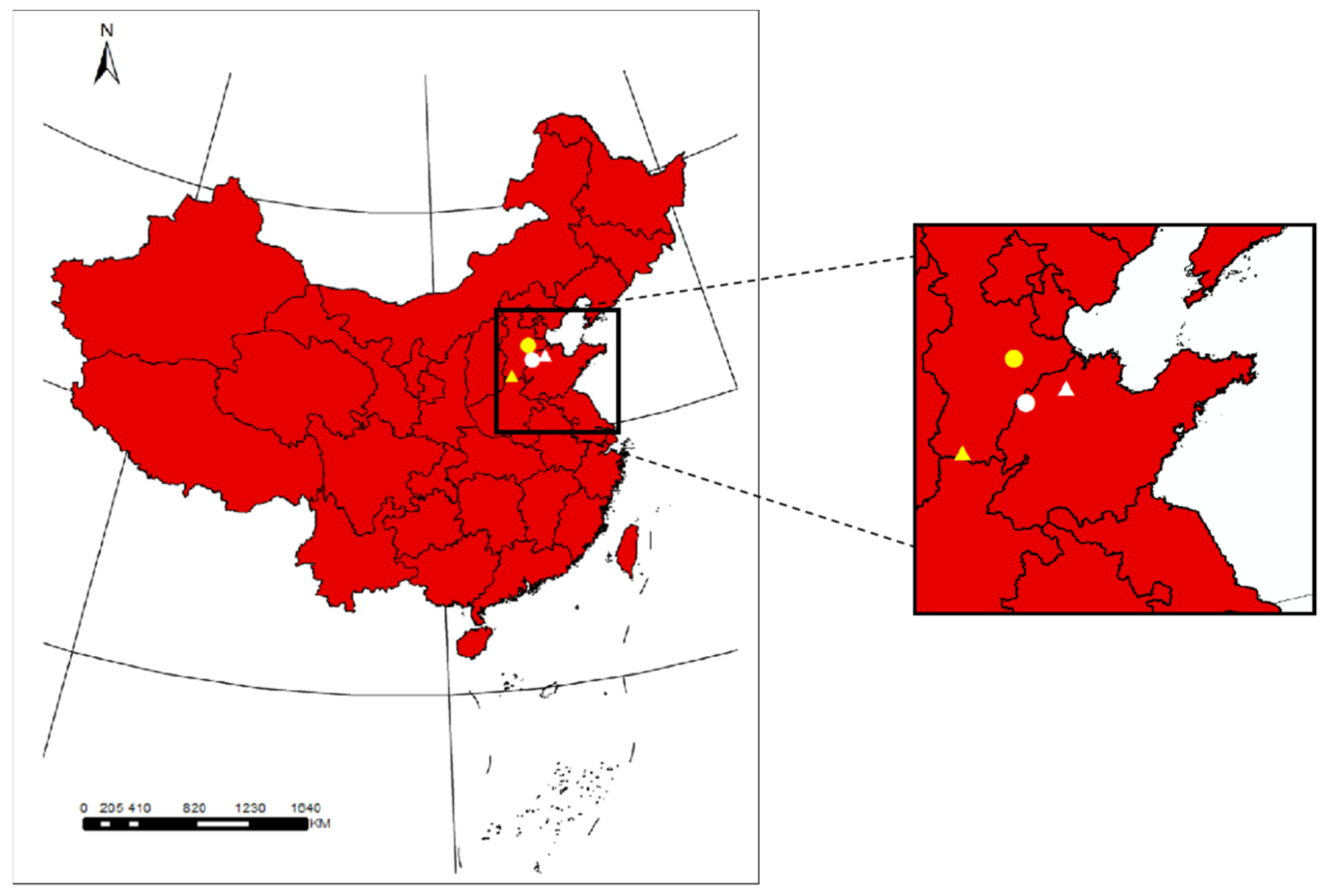
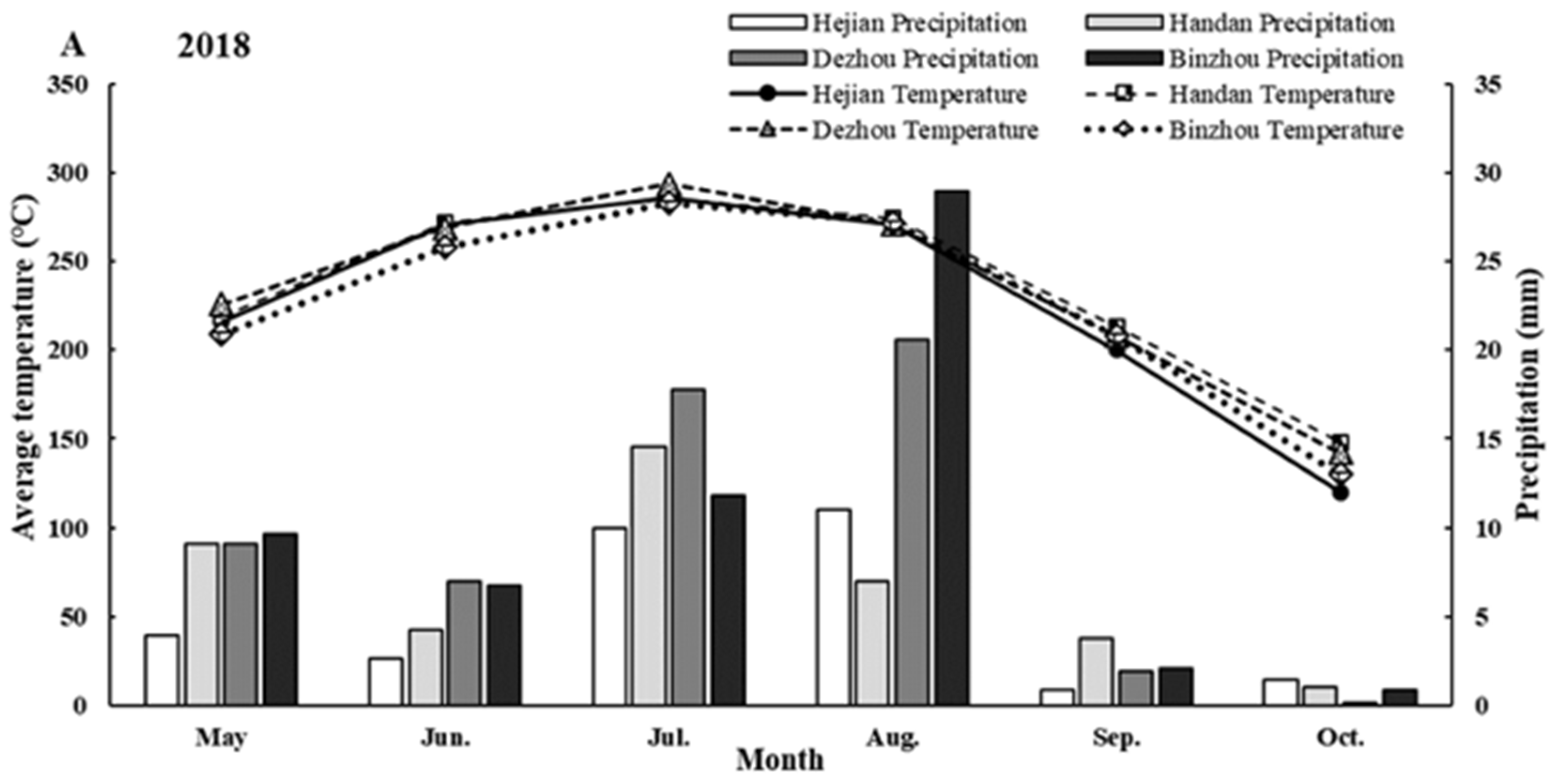

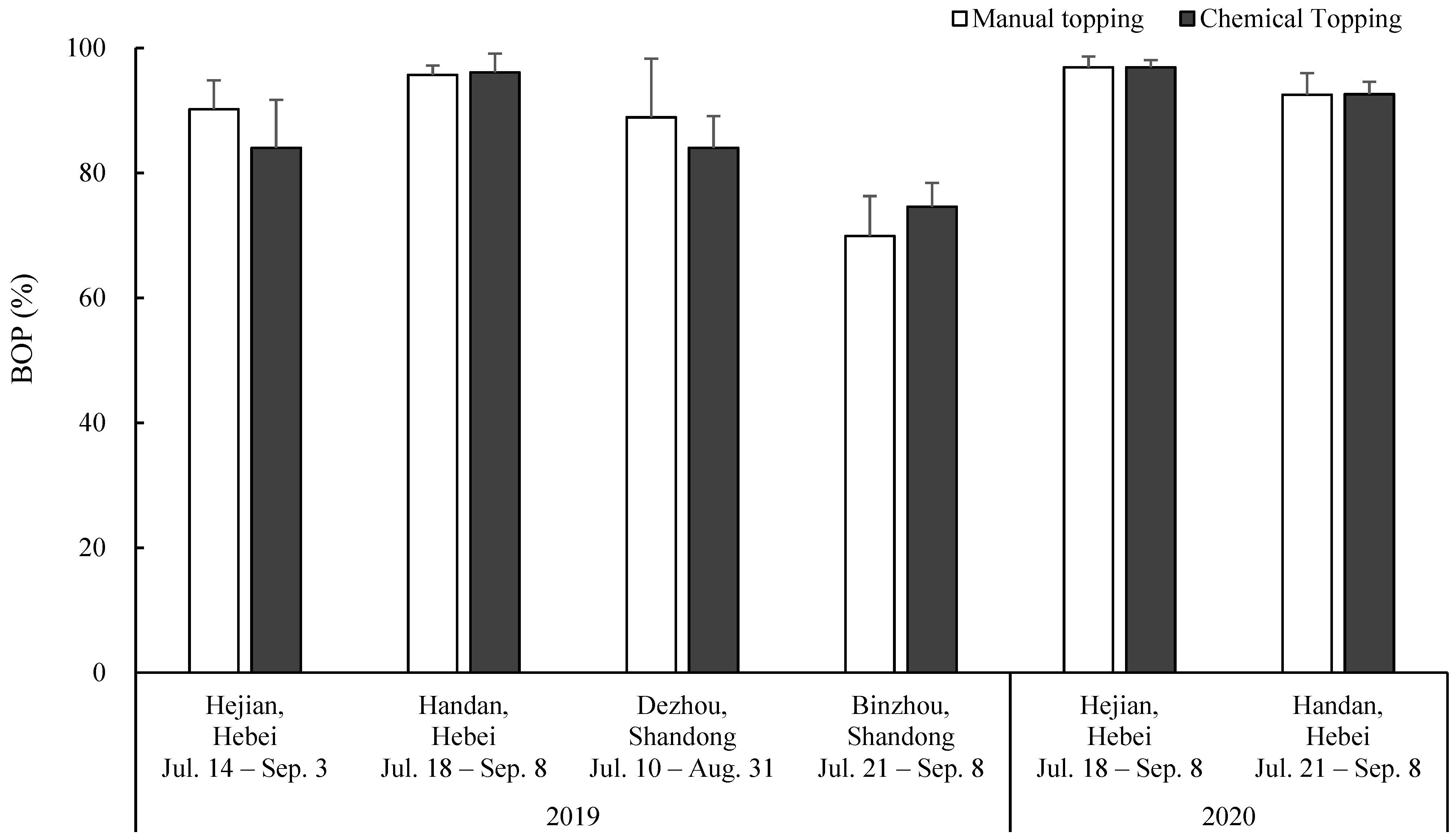
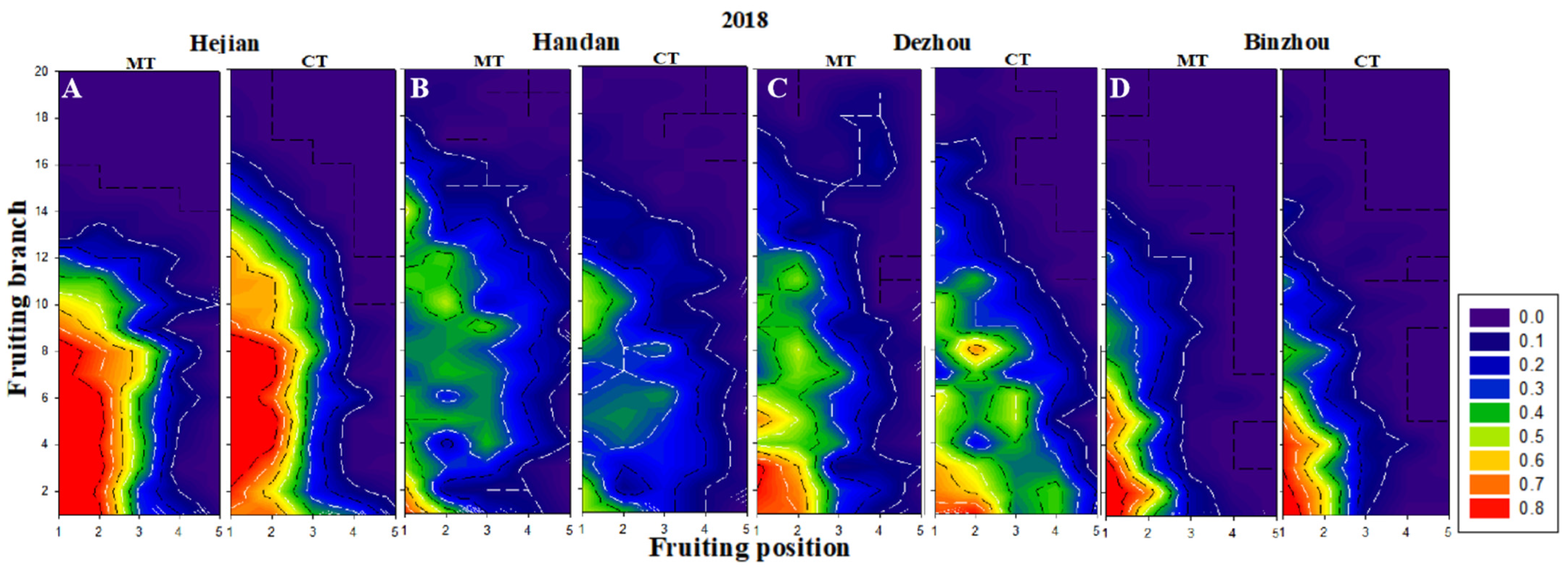
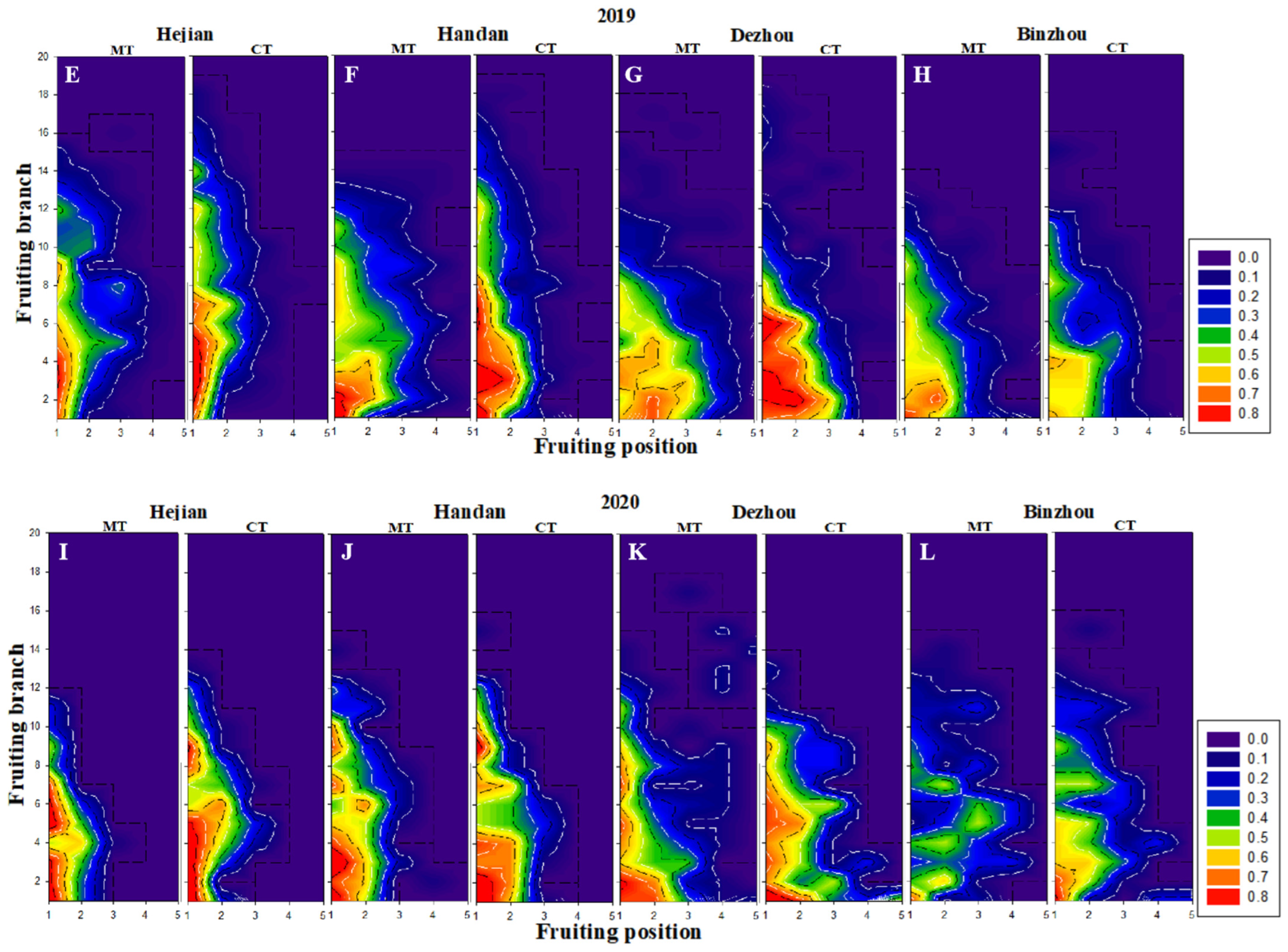
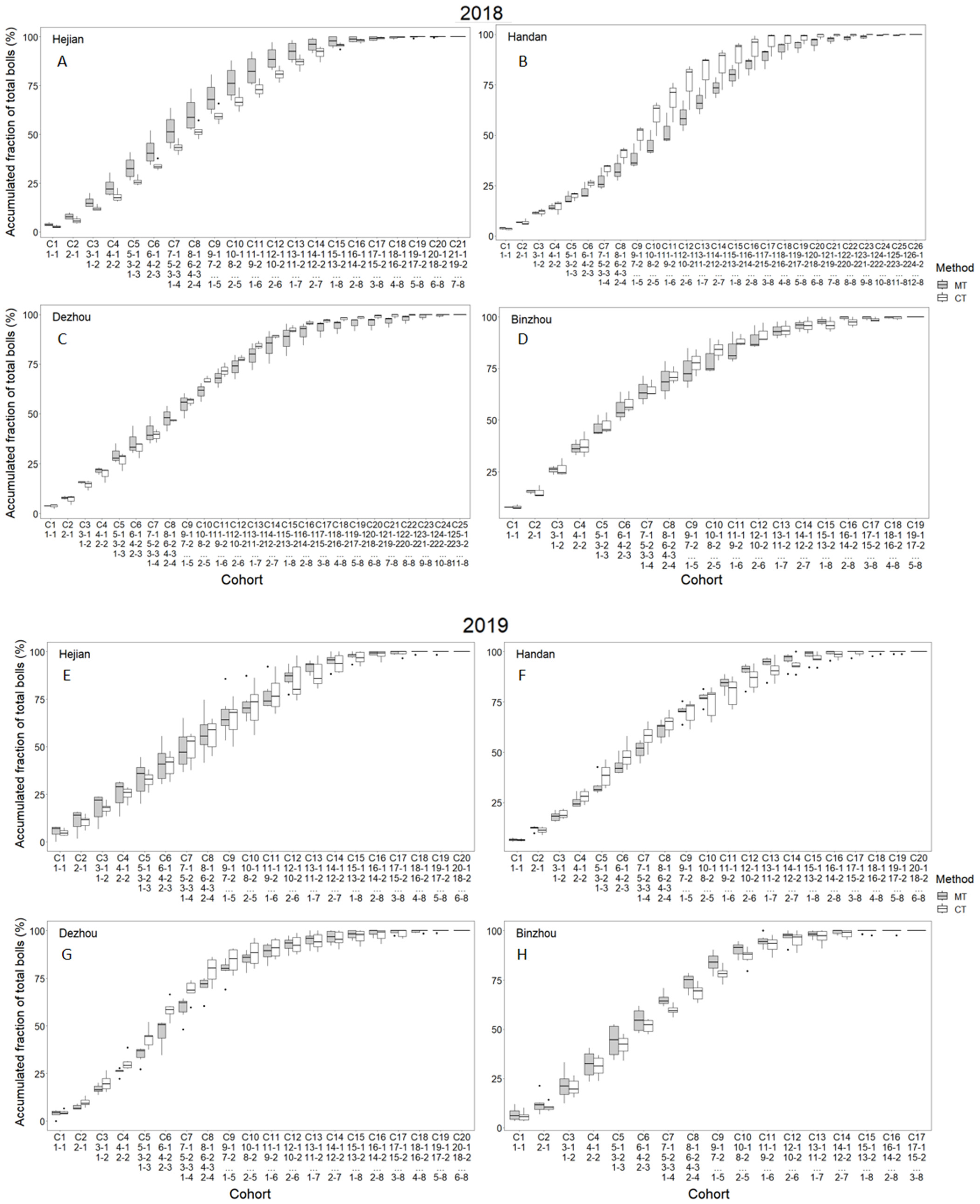
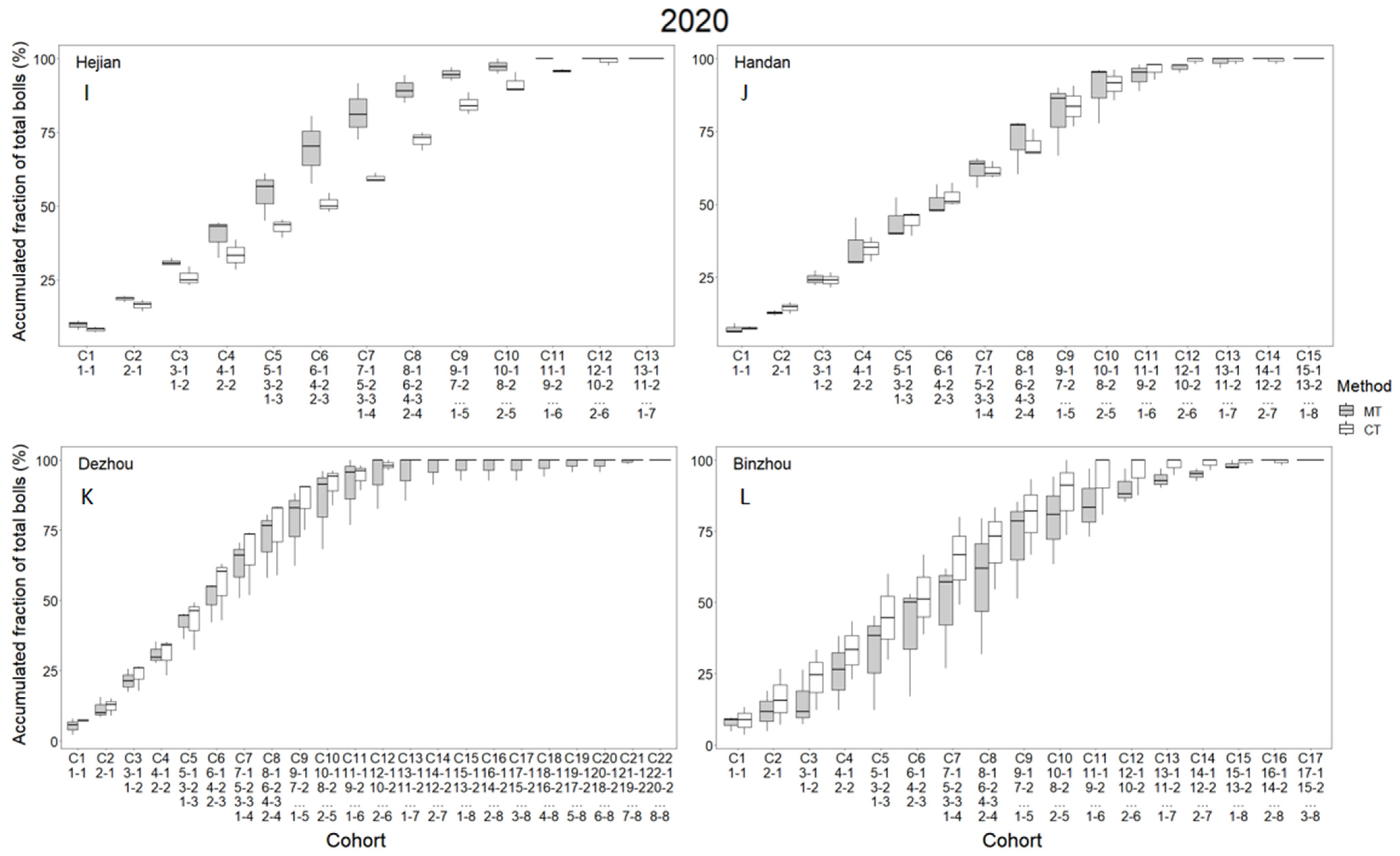

| Year | Location | Variety | Row Spacing (cm) | Plant Density (104 Plant ha−1) | Sowing Date | Manual Topping Date | Frequency of Regular MC * Application | Rate of Regular MC Application (g ha−1) | Nitrogen Rate (kg ha−1) | Date of Harvest Aids Applied |
|---|---|---|---|---|---|---|---|---|---|---|
| 2018 | Hejian, Hebei | Xinkang4 | 76 | 9.0 | April 27 | July 20 | 3 | 147.0 | 150 | — |
| Handan, Hebei | Han853 | 66 | 5.3 | April 26 | July 17 | 1 | 120.0 | 0 | — | |
| Dezhou, Shandong | Lumianyan37 | 76 | 4.5 | April 28 | July 26 | 6 | 397.5 | 0 | — | |
| Binzhou, Shandong | Lumianyan37 | 76 | 6.0 | April 25 | July 25 | 0 | 0 | 150 | — | |
| 2019 | Hejian, Hebei | Guoxin18-4 | 76 | 9.0 | May 1 | July 22 | 3 | 240.0 | 75 | September 23 |
| Handan, Hebei | Guoxin18-4 | 76 | 9.3 | April 28 | July 16 | 1 | 30.0 | 150 | September 19 | |
| Dezhou, Shandong | Guoxin18-4 | 76 | 4.5 | April 29 | July 18 | 6 | 360.0 | 0 | September20 | |
| Binzhou, Shandong | Guoxin18-4 | 76 | 6.0 | May 9 | July 20 | 5 | 412.5 | 150 | September 22 | |
| 2020 | Hejian, Hebei | Guoxin26 | 76 | 9.0 | April 24 | July 20 | 5 | 225.0 | 150 | September 16 |
| Handan, Hebei | Guoxin26 | 76 | 9.3 | April 25 | July 14 | 5 | 300.0 | 150 | September 12 | |
| Dezhou, Shandong | Guoxin26 | 76 | 6.8 | April 27 | July 16 | 6 | 307.5 | 150 | September 25 | |
| Binzhou, Shandong | Guoxin26 | 76 | 7.5 | April 29 | July 17 | 5 | 300.0 | 150 | September 18 |
| Location | Treatment | Boll Density (104 Bolls ha⁻ˡ) | Average Boll Weight (g boll⁻ˡ) | Seed Cotton Yield (kg ha⁻ˡ) | Lint Percentage (%) |
|---|---|---|---|---|---|
| Hejian, Hebei | MT | 76.2 | 5.6 | 3098.8 | 44.2 |
| CT | 98.3 | 6.0 | 3366.3 | 41.7 | |
| Handan, Hebei | MT | 124.5 a | 5.9 | 5534.5 a | 43.3 |
| CT | 86.3 b | 6.1 | 4290.7 b | 42.0 | |
| Dezhou, Shandong | MT | 86.2 b | 5.5 | 3995.3 | 42.5 |
| CT | 97.6 a | 5.8 | 3773.0 | 42.1 | |
| Binzhou, Shandong | MT | 98.9 | 4.8 | 3708.8 | 44.0 |
| CT | 97.4 | 5.1 | 3669.9 | 43.9 |
| Location | 2019 | 2020 | ||||||
|---|---|---|---|---|---|---|---|---|
| Boll Density (104 bolls ha⁻ˡ) | Average Boll Weigh t (g boll⁻ˡ) | Seed Cotton Yield (kg ha⁻ˡ) | Lint Percentage (%) | Boll Density (104 bolls ha⁻ˡ) | Average Boll Weight (g boll⁻ˡ) | Seed Cotton Yield (kg ha⁻ˡ) | Lint Percentage (%) | |
| Hejian, Hebei | 103.25 a | 5.68 c | 4510.5 c | 44.0 ab | 88.4 b | 5.66 c | 4424.0 a | 44.6 b |
| Handan, Hebei | 109.8 a | 6.07 b | 5741.2 a | 43.4 b | 112.65 a | 5.73 c | 4322.7 a | 42.0 c |
| Dezhou, Shandong | 67.25 b | 6.92 a | 4944.9 b | 45.1 a | 105.85 a | 6.58 b | 4448.8 a | 46.1 a |
| Binzhou, Shandong | 64.4 b | 6.20 b | 3716.7 d | 43.1 b | 75.4 c | 6.83 a | 3804.9 b | 46.5 a |
| Treatment | ||||||||
| Manual topping | 89.3 | 6.12 | 4697.0 | 44.3 | 92.5 | 6.15 | 4238.7 | 44.9 |
| Chemical topping | 85.7 | 6.23 | 4726.1 | 43.5 | 97.6 | 6.17 | 4288.2 | 44.7 |
| ANOVA | ||||||||
| Treatment | ns | ns | ns | ns | ns | ns | ns | ns |
| Location | <0.01 | <0.01 | <0.01 | 0.011 | <0.01 | <0.01 | 0.037 | <0.01 |
| Treatment × Location | ns | ns | ns | ns | ns | ns | ns | ns |
Disclaimer/Publisher’s Note: The statements, opinions and data contained in all publications are solely those of the individual author(s) and contributor(s) and not of MDPI and/or the editor(s). MDPI and/or the editor(s) disclaim responsibility for any injury to people or property resulting from any ideas, methods, instructions or products referred to in the content. |
© 2023 by the authors. Licensee MDPI, Basel, Switzerland. This article is an open access article distributed under the terms and conditions of the Creative Commons Attribution (CC BY) license (https://creativecommons.org/licenses/by/4.0/).
Share and Cite
Qi, H.; Xiao, C.; Zhao, W.; Xu, D.; Eneji, A.E.; Lu, Z.; Shao, R.; Wang, G.; Du, M.; Tian, X.; et al. Chemical Topping with Mepiquat Chloride at Flowering Does Not Compromise the Maturity or Yield of Cotton. Agronomy 2023, 13, 497. https://doi.org/10.3390/agronomy13020497
Qi H, Xiao C, Zhao W, Xu D, Eneji AE, Lu Z, Shao R, Wang G, Du M, Tian X, et al. Chemical Topping with Mepiquat Chloride at Flowering Does Not Compromise the Maturity or Yield of Cotton. Agronomy. 2023; 13(2):497. https://doi.org/10.3390/agronomy13020497
Chicago/Turabian StyleQi, Haikun, Chenyu Xiao, Wenchao Zhao, Dongyong Xu, Anthony Egrinya Eneji, Zhengying Lu, Rongrong Shao, Guifeng Wang, Mingwei Du, Xiaoli Tian, and et al. 2023. "Chemical Topping with Mepiquat Chloride at Flowering Does Not Compromise the Maturity or Yield of Cotton" Agronomy 13, no. 2: 497. https://doi.org/10.3390/agronomy13020497
APA StyleQi, H., Xiao, C., Zhao, W., Xu, D., Eneji, A. E., Lu, Z., Shao, R., Wang, G., Du, M., Tian, X., & Li, Z. (2023). Chemical Topping with Mepiquat Chloride at Flowering Does Not Compromise the Maturity or Yield of Cotton. Agronomy, 13(2), 497. https://doi.org/10.3390/agronomy13020497






